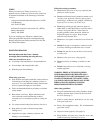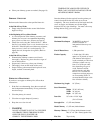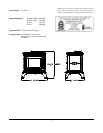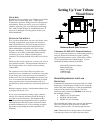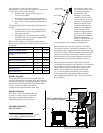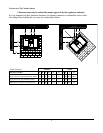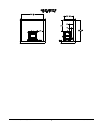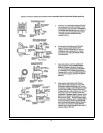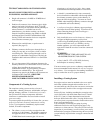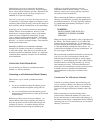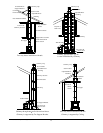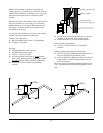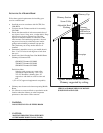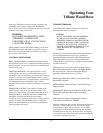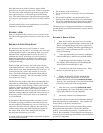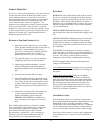
HearthStone Quality Home Heating Products Inc ® Tribute Model 8040
11
VENTING COMPONENTS AND CONFIGURATION
DO NOT CONNECT THIS UNIT TO A CHIMNEY
FLUE SERVING ANOTHER APPLIANCE
• Single wall connector is 24 MSG or 25 MSG blued
steel stovepipe.
• Double wall connector (close clearance pipe) which
must be used with a listed factory-built “Type HT"
chimney also may be used with a masonry chimney to
reduce clearances, is available from several
manufacturers, your dealer can help you choose.
Some air insulated connector pipe models available
are Simpson Dura Vent DVL and Metalbestos DS.
Security, GSW and Ameritec also have acceptable
close clearance connector pipe.
• When used in a mobile home, a spark arrester is
required. (See page 15)
• Chimney connector shall not pass through floor or
ceiling, nor any attic or roof space, closet or similar
concealed space. Where passage through a wall or
partition of combustible construction is desired, the
installation shall conform to NFPA 211 or CAN/CSA
- B365.
• It is very important to follow minimum clearances for
chimney connectors to combustibles such as walls and
ceilings when installing the stove near non-
combustible surfaces. Typical chimney connector
clearances are outlined below. The single wall
clearances are generic; the Double wall clearances are
for Simpson Dura Vent DVL, CHECK THE
SPECIFICATIONS FROM THE
MANUFACTURER OF YOUR CONNECTOR.
Components of a Venting System
The complete venting system consists of several
components: chimney connector, wall thimble, wall pass-
through, chimney, and liner. It is absolutely necessary
that you install all of these components within the
clearances to combustibles discussed earlier to install
your stove safely.
To protect against the possibility of a house fire, you must
properly install and constantly maintain the venting
system. Upon inspection, immediately replace rusted,
cracked, or broken components.
• The chimney connector is the stovepipe from the
woodstove to the chimney. The chimney connector
stovepipe must be 6" (152 mm) diameter, 24 MSG or
25 MSG blued steel connector pipe. Do not use
aluminum or galvanized steel pipe - they cannot
withstand the extreme temperatures of a wood fire.
• A thimble is a manufactured (or site-constructed)
device installed in combustible walls through which
the chimney connector passes to the chimney. It
keeps the walls from igniting. You must use a wall
thimble when installing a chimney connector through
a combustible wall to the chimney.
• A wall pass-through (or chimney support package)
also keeps the walls from igniting. You must use one
when connecting through a wall or ceiling to a
prefabricated chimney.
• Only install this stove to a lined masonry chimney or
an approved high temperature prefabricated
residential type building heating appliance chimney.
Do not connect this stove to a chimney serving
another appliance; you will compromise the safe
operation of both the wood stove and the connected
appliance.
¦ WARNING:
DO NOT CONNECT THIS APPLIANCE TO ANY
AIR DISTRIBUTION DUCT OR SYSTEM.
• A liner is the UL 1777 or ULC S635 (for factory
built fireplace or masonry) chimney.
You must connect your stove to a chimney comparable to
those recommended in this manual. Do not use stovepipe
as a chimney. Use stovepipe for freestanding installations
only to connect the stove to a proper chimney.
Installing a Venting System
Stovepipe sections must be attached to the stove and to
each other with the crimped end toward the stove. If
creosote builds up, this allows the creosote to run into the
stove and not the outside of the stovepipe and onto the
stove.
Secure all joints, including attaching the stovepipe to the
stove's flue collar, with three sheet metal screws. Install
#10 x 1/2" (3 mm x 13 mm) sheet metal screws into the
holes pre-drilled in the flue collar. Leaving off the screws
can cause joints to separate from the vibration that results
from a creosote chimney fire.
You can simplify connecting stovepipe by using
additional accessories such as telescoping pipes, slip-
connectors or clean-out tees. These accessories ease the
inspection of your chimney, as well as allow you to easily
dismantle the stovepipe (without moving the stove) when
you periodically inspection the stovepipe connection and
chimney.



